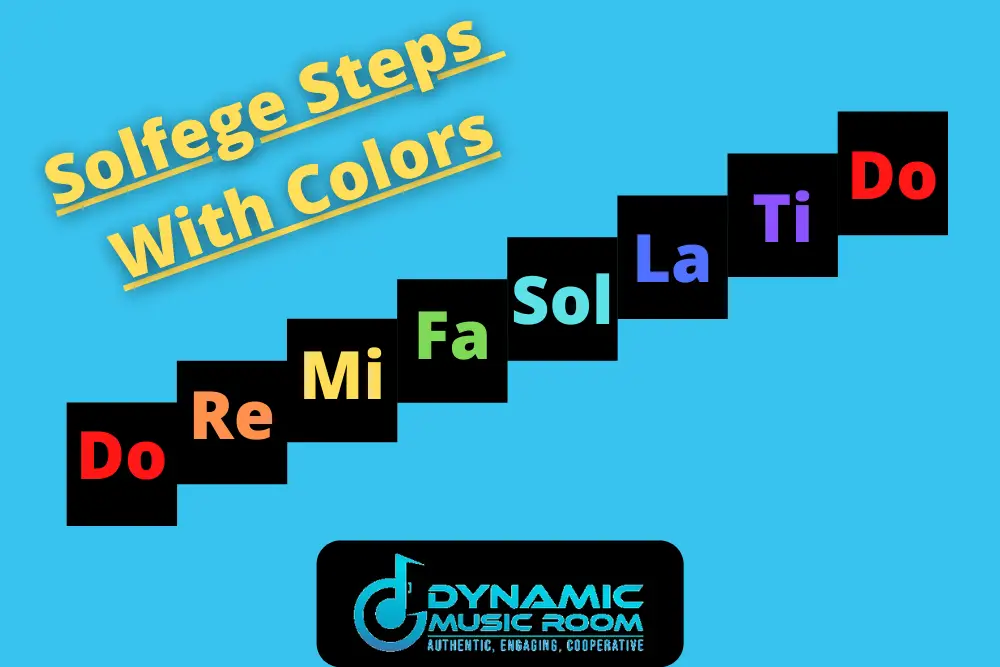Have you heard the term before but never knew what it was?
Do you want an excellent visual for helping students connect how the solfege pitches fit together?
I’ve enjoyed learning solfege, but I knew I needed to up my game when it came time to teach it.
Enter the solfege ladder.
A solfege ladder is a vertical representation of how the notes relate to each other in the scale. It shows where there are steps, skips, and leaps. Solfege ladders help reach the visual and kinesthetic intelligences.
Check out the rest of the post for more details and examples on solfege ladders.
Table of Contents
Solfege Ladder Explanation
As mentioned above, a solfege ladder is simply a visual way of showing how the solfege pitches relate to one another.
There is no standard format.
Originally, teachers used the visual of rungs on a ladder to show where the solfege notes sat.
Now, the term applies to most any vertical and visually oriented graphic showing solfege.
Hand signs are optional and sometimes left out.
Here are the common elements of solfege ladders:
- Vertical oriented
- Shows places for each solfege syllable
- Often features removable solfege to add onto as students learn more syllables
- May be color coordinated
- Often indicates how close notes are (i.e., how Mi and Fa are only a half step away)
Traditional Solfege Ladder
Here is an example of a traditional solfege ladder.
Notice how the notes sit on the rungs of the ladder.
Also, notice how the rungs for Mi-Fa and Ti-Do are closer than the others are.
This shows the closer interval of half note.

Alternative Solfege Visual
This is another visual which evolved from the solfege ladder.
Now, we’re not showing a ladder at all.
They’re steps!
Notice how color coordination is added.
The colors do line up with typical boom whackers and handbell colors for the note names.

Solfege Ladders To Buy
If you don’t want to print or make your own (the two from above are FREE to yank and use in your room; just share a link to this page if you use it on a website), go ahead and buy one of the premade ones.
I used to do this until the world got more technological.
Now, I show mine with a projector when I need to use it.
But here are some good options to check out at affordable prices on Amazon.
Disclaimer: Affiliate links ahead. We may earn a small commission at no extra cost to you if you click and buy one of these.
How To Use A Solfege Ladder
Here are a few quick ways to use a solfege ladder and other solfege graphics to help your students.
There are many more, but these are a few I find myself using in the classroom all the time.
Point And Sing
This one is simple: students point at the solfege and sing a song they know well.
This is also done through echoing.
You sing and touch the solfege; they echo it back to you.
Yes, this is simple, but not every activity needs to be complicated.
Echo Back
For an advanced twist on the point and sing approach, you point to the syllable on the ladder but don’t sing.
The students have to watch, hear inside their heads, and sing it back to you.
This one forces them to be more independent and challenges their inner ear.
Solfege Memory
Let’s take the previous activity and make it even harder.
Do you remember the little Simon Says or Memory game?
The one with four lights?
It lights up one light, and you press it.
Then it lights up two, and you need to remember both of those.
It keeps adding until you fail, and you see how far you go.
Do the same game with the solfege ladder.
Add pitches one at a time, making the melody longer and longer.
Challenge the classes to see how far they make it.
Write their scores somewhere for an added challenge.
Guess The Mystery Song
Hum the first pitch; then point (don’t sing) a song they know.
Students have to watch and figure out the mystery song.
Block The Pitch
Sing a well-known song together, pointing at the solfege ladder.
Now, place a block over one of the solfege pitches.
They sing the song in solfege, but they must internalize it when they get to the blocked note.
Commonly Asked Questions
Does it have to be a ladder? – Traditionally, it was a ladder, but the visuals have since evolved to be anything.
Consider what you’re looking for and what you’d like to use it to see what you need to have in one of your own.
What is the order of solfege? – Typically, the order of solfege goes:
Do-Re-Mi-Fa-Sol-La-Ti-Do.
This is, of course, assuming you’re singing in moveable do and in a major key.
If you’re singing in Minor, you may end up with La-Ti-Do-Re-Mi-Fa-Sol-La as your order.
Check out more about solfege in minor scales.
Is it Si-Do or Ti-Do? – Back in the day, they didn’t use Ti or Si at all.
The original singers avoided the leading tone because it would create a tritone combined with Fa.
This was called the Devil’s Interval hundreds of years ago.
Si came from the original hymn inspiring the syllables.
Si stands for Sancto Iohannes or Saint John.
Teachers switched to Ti later to give each syllable its starting letter.
Learn more about the solfege syllables throughout time.
How do you know which notes are which solfege? – Essentially, you line the letters in a key up with the solfege syllables.
For more details, check out our solfege to note translations.
Final Thoughts
Now you know what a solfege ladder is and how to apply it to learning.
These visual representations are awesome to use in the classroom.
It reaches visual and kinesthetic intelligences easily.
I highly recommend everyone use these when teaching solfege.
You may also want to check out these 8 solfege exercises for musical improvement.

